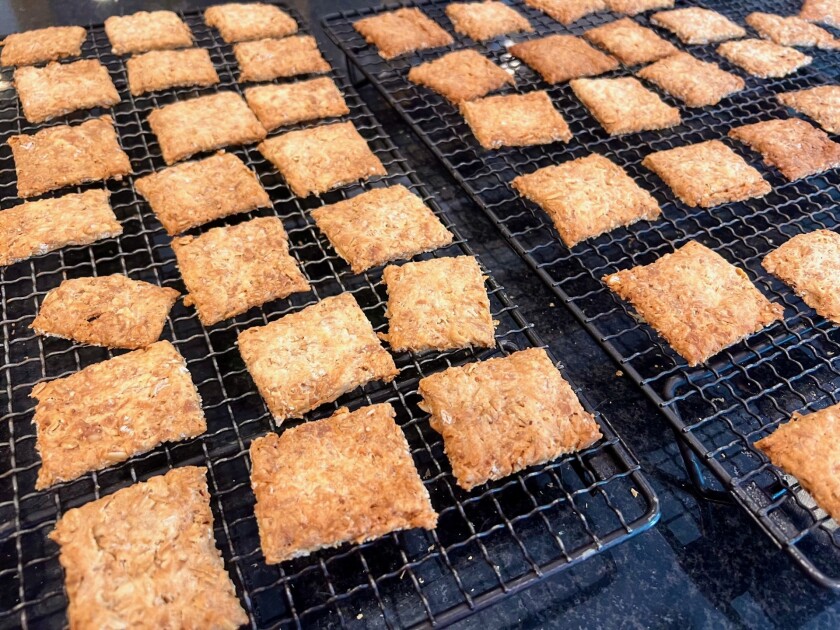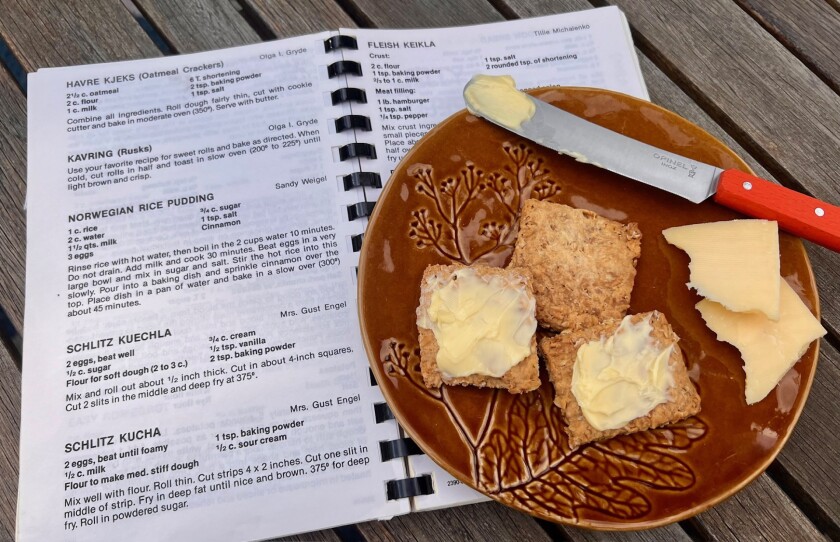September means many of us are back to school and activities, and for most parents, that also means we’re back to packing or advising our young people about healthy snacks.
My ongoing project of making and learning about recipes from “The Joy of Sharing,” the 1985 church cookbook published by the Oak Valley American Lutheran Women of Velva, North Dakota, offered an opportunity to discover what parents might have reached for to tuck into their children’s backpacks. Contributed by Olga I. Gryde, the recipe for Havre Kjeks (Oatmeal Crackers) fit the requirement perfectly.
At first glance, this recipe appears simple. The ingredients are few and common: oatmeal (type unspecified — I assumed a cracker would have a long baking time, and so I went with old fashioned rolled oats rather than steel cut or quick oats), flour, baking power, salt, shortening and milk. The instructions are spare too: “Combine all ingredients. Roll dough fairly thin, cut with cookie cutter and bake in moderate oven.”

Oatmeal is the star of the show in Havre Kjeks.
Contributed / Karla Knutson
Yet such simplicity can be deceptive. Much of my preparation required knowledge and experience: recognition of a dough too dry to adhere (I added another splash of milk and a touch more shortening) and of how to roll out the dough to the desired thinness.
After finding the rolling action picked up too much dough, even after taking preventative measures first with flour and then shortening, I discovered that the continuous concussive movement of pounding out from the center — the technique typically used with cutlets — using first the bottom of a heavy glass and then the base of my palm kept the dough in place while flattening it.
Baking was a mystery as well, with only the moderate oven temperature of 350 degrees Fahrenheit specified. I knew crackers should be dry and crisp and kept a close eye on them. They eventually baked for 50 minutes before emerging from the oven a beautiful golden brown.
The vague nature of the recipe is both Gryde’s doing and also not her doing. She submitted it for inclusion in “The Joy of Sharing,” and as is conventional in community cookbooks, the recipe bears her name. However, Gryde’s recipes for “Havre Kjeks” and “Kaving (Rusks)” are almost identical to those in Julia Peterson Tufford’s “Original Scandinavian Recipes.” Gryde adds oven temperatures yet removes Peterson Tufford’s evaluative comments.

Cut the dough into 2-inch square crackers or use a decorative cookie cutter for a fun change.
Contributed / Karla Knutson
Recipes do not receive copyrights, and so technically, this is allowed. Certainly, many other recipes in “The Joy of Sharing” and in the thousands of other community cookbooks published in the 19th and 20th centuries came from unattributed sources.
For example, in
July’s “Vintage Dishes,” I noted that the source of Cathy Knutson’s recipe for “Liver Slices”
was the McHenry County Extension Agent, Colleen Roe.
Most home cooks occasionally create new recipes and surely put their individual spin on recipes they find in cookbooks and receive from friends and family members.
Many professional chefs’ dishes reinvent or draw upon recipes from diverse culinary traditions and often give credit to their sources in the introductions to recipes in a cookbook or in the title of the dish listed on a menu. The genre of the recipe is a blend of innovation and adaptation.
But there’s still something about the practice of submitting an unattributed, almost verbatim recipe to a community cookbook that rankles my sensibilities as an English professor. I’d feel a lot more comfortable if community cookbooks had a new feature, such as an additional line to indicate the recipe’s source. Sometimes the contributor does this in the title, as in Geraldine Florence’s “Helen’s Cauliflower Soup,” and sometimes in the narrative.
But wouldn’t it be wonderful if we could trace those sources and the relationships and preferences? What an amazing gift it would be to know that your grandmother’s cookies came from “Joy of Cooking” or from the Toll House chocolate chip package, as is finally discovered in a
famous scene from the 1990 sitcom “Friends.”
Knowing a contributor’s influences helps us learn more about their culinary preferences and practices.

The oatmeal gives the crackers a beautiful texture and golden color.
Contributed / Karla Knutson
Given what I know about Gryde, I’m not surprised she had a copy of “Original Scandinavian Recipes,” a cookbook originally published in 1940 and issued in its 44th printing in 2022.
Peterson Tufford describes the purpose of her collection is “to gather into one volume these simple ‘folk recipes’ that were so familiar in your childhood and mine, thus preserving them for the future.” She mentions a number of her sources in the introduction and thanks those who shared recipes with her.

Gryde’s recipe for oatmeal crackers comes from “Original Scandinavian Recipes.”
Contributed / Karla Knutson
Gryde, too, was invested in preserving her heritage. In addition to contributing Scandinavian dishes to “The Joy of Sharing,” Gryde was quoted in and contributed several images of her mother, Sarah Knutson Gryde to H. Elaine Lindgren’s book “Land in Her Own Name: Women as Homesteaders in North Dakota.”
Sarah Knutson was one of the thousands of women who took advantage of the Homestead Act and “proved up,” living on and improving their parcel of land to meet the government’s requirements to become its owner.

Smeared with butter, these crackers are a perfect mixture of sweet and savory, crunchy and creamy.
Contributed / Karla Knutson
Though I do think these oatmeal crackers are very tasty, particularly when smeared with good butter, as is traditional, or as the savory base for a tiny tower of cheese and salami, the benefit of making them has been what I’ve learned and what they call to mind for me — eating flatbread and crackers with my great aunt Joy, who also taught me how to adorn them with beautiful designs made with spray cheese.
Discovering the source of Gryde’s havre kjeks has made my life richer.

Karla Knutson is Professor of English at Concordia College in Moorhead. She is cooking her way through her mother’s copy of “The Joy of Sharing,” a cookbook published in 1985 by the Oak Valley American Lutheran Church Women — the women’s group at the church she attended as a child in Velva, North Dakota. Contact her at knutson@cord.edu and read more of her cooking adventures on her blog.


Dining and Cooking